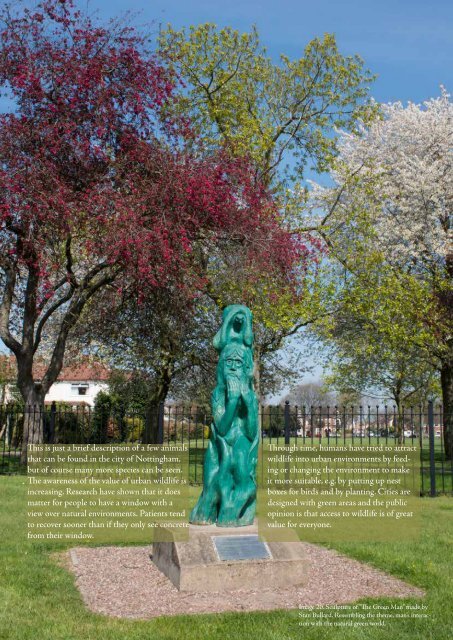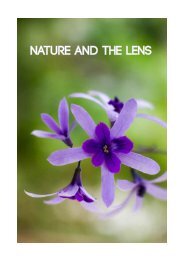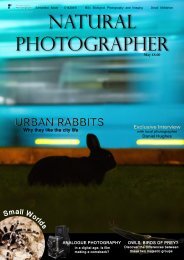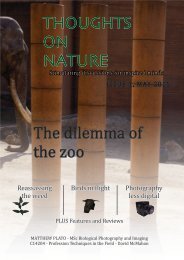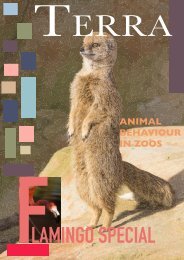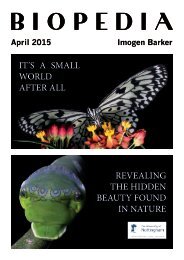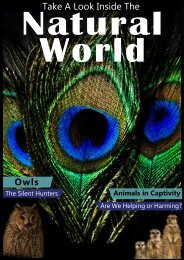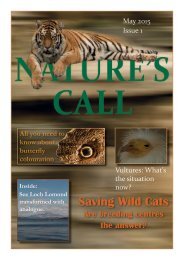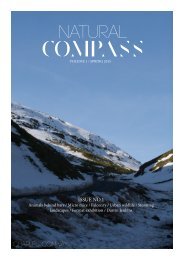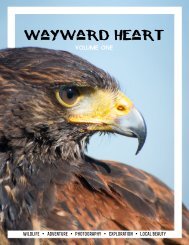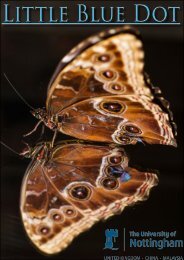NATURA
Create successful ePaper yourself
Turn your PDF publications into a flip-book with our unique Google optimized e-Paper software.
F<br />
c<br />
ss<br />
c<br />
g<br />
This is just a brief description of a few animals<br />
that can be found in the city of Nottingham,<br />
but of course many more species can be seen.<br />
The awareness of the value of urban wildlife is<br />
increasing. Research have shown that it does<br />
matter for people to have a window with a<br />
view over natural environments. Patients tend<br />
to recover sooner than if they only see concrete<br />
from their window.<br />
Through time, humans have tried to attract<br />
wildlife into urban environments by feeding<br />
or changing the environment to make<br />
it more suitable, e.g. by putting up nest<br />
boxes for birds and by planting. Cities are<br />
designed with green areas and the public<br />
opinion is that access to wildlife is of great<br />
value for everyone.<br />
Image 20. Sculpture of “The Green Man” made by<br />
Stan Bullard. Resembling the theme, man’s interaction<br />
with the natural green world.<br />
Focus stacking is a technique in digital image processing<br />
where two or more images are layered together to make one<br />
image with increased depth of field. To use this technique, a<br />
series of images must be taken at different depths. It depends<br />
on the aperture how many focus points are needed to get the<br />
depth of field required. The wider the aperture (smaller F),<br />
the more images are needed.<br />
The best way to take the images is to have the camera in a<br />
locked position, either on a tripod or by using Macro focusing<br />
rail (hand hold is almost impossible). By focusing the<br />
camera manually with different focus areas, or by focusing<br />
automatically moving the focus point for each image, and<br />
then laying them all together having the computer screening<br />
out the focus areas, the depth of field can be increased.<br />
This process to screen out the focus areas can be done with<br />
software such as Photoshop, Helicon and Zerene Stacker.<br />
They all follow the same basics.<br />
When using Photoshop, the first step is to open all the images<br />
and then choose File - Automate - Photomerge. A window<br />
will open with a few different processes. The best way is to<br />
select Auto and then deselect Blend images together. The<br />
next step is to select Add open files and then the open images<br />
will appear in the box. Click OK, wait a few seconds and give<br />
the program time to process. A new image will appear with<br />
the title Untitled panorama, and with layers as many as the<br />
original images. Select all the layers and click - Edit - Auto<br />
Blend layers and another dialogue box will open. Make sure<br />
to select Stack images and press Ok. Photoshop will then<br />
select the sharpest area of each image and mask of the rest.<br />
This should result in a sharp image with a great depth of<br />
field.<br />
When is focus stacking used?<br />
It is useful in macro photography where it is frequently used.<br />
For biologists, this method is important when taking images<br />
in a microscope or a stereoscope where time, ISO, light and<br />
magnification are the only things possible to control.<br />
Focus stacking is used in landscape photography when the<br />
photographer is aiming for sharp large prints. It is also useful<br />
when light is limited and long exposure cannot be used.<br />
natura_____21


